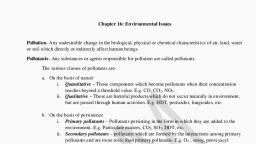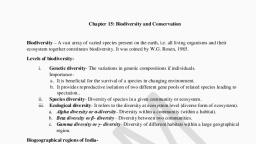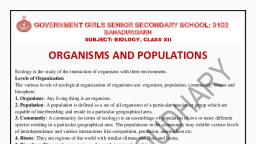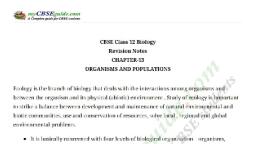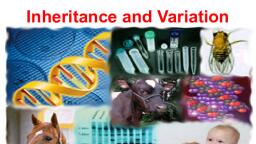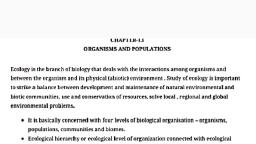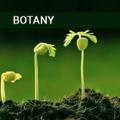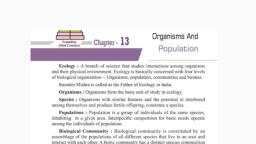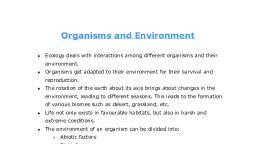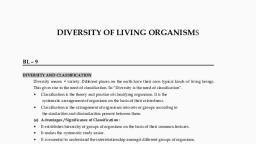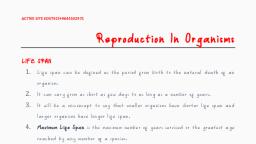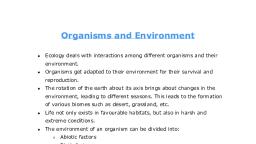Page 1 :
Organisms and Population, Ecology- It is the branch of science which deals with the interelationship between living organism and its, physical environment., The term ecology was coined by Ernst Haeckel, 1869., R. Misra is known as Father of ecology in India., Haeckel - “The study of plants and animals in reciprocal relationship with their environment”., Odum - “The study of structure and function of nature”., Branches of plant ecologyAutecology – Study of individual plant or the population of individual plant species in relation to, environment., Synecology – Study of plant communities (group of different species) and their relationship with, environment., Levels of biological organization:, •, , Organism- Each individual of a species., , •, , Population- Organisms with similar features and interbreed among themselves., , •, , Community- An assemblage of population of different species., , •, , Biome- A large ecological unit constituting distinctive plant and animal species., , Organism and its environment:, Environment- It is the sum total of all biotic and abiotic factors that surround and potentially, influence organisms., Weather – The short term properties of the atmosphere such as heat, cold, cloud, rain, wind, etc., at, a given place and time., Climate – It refers to the average weather conditions of a particular area., , , , , Climatic zone, , Latitude, , Winter season, , 0°-20°, 20°-40°, , Average mean, temperature, Above 24° C, 17°-24° C, , Tropical zone, Sub-tropical, zone, Temperate zone, , 40°-60°, , 7°-17° C, , 60°-80°, , Below 7° C, , Winter with occasional, snow, Severe, prolonged, winter with abundant, snow, , Arctic/Tundra, zone, , Nil, Mild winter, , Characteristic, vegetation, Tropical forests, Mixed Sun-tropical, deciduous forests, Mixed coniferous, forests, Arctic vegetation, , Habitat – It refers to a specific place where a species normally lives., Niche – It is the specific part of habitat occupied by individuals of a species which is, circumscribed by its range of tolerance, microclimate and resources availability. Or It refers to the, functional role a species plays in its habitat.
Page 2 :
Habitat, a. It refers to a specific physical area, where a species lives., b. More than one species can live in the, same habitat., c. Habitat of a species does not change., , a., b., c., , Niche, It refers to the role a species plays, in its habitat., Only one species can live in one, ecological niche., A species may change its niche, with age and season., , Terrestrial Biomes, 1., , Tundra: The region above 60o N Latitude (Timberline) and soil is characterized by permafrost;, annual rainfall below 20cm/yr., Flora: Vegetation is characterized by lichen and mosses;, Fauna: mostly warm blooded like polar bear, arctic fox, etc., , 2., , Tiaga or coniferous forest or Temperate needle-leaf forest:, Annual rainfall is 50-170 cm/yr., Flora: Pine, Maple, Silver fir, Spruce, etc., Fauna: mouse, wolves, deer, rabbits, etc., , 3. Temperate deciduous forest:, Annual rainfall is 100-250 cm/yr., Flora: Oak, Maple, Birch, etc., Fauna: frog, turtle, lizards, snakes, rabbits, etc., 4., , Tropical Rain forest:, Annual rainfall is 200-450 cm/yr. Richest diversity,, and well defined vertical stratification., Flora: Dipterocarpus, Hopea, epiphytes, etc., Fauna: Arboreal (tree dwellers), deer, leopard, jaguar, etc., , 5., , Tropical Deciduous forest:, Annual rainfall is 90-160 cm/yr., Flora: Sal, Teak, Tendu, Khair, etc., Fauna: somewhat similar to tropical rain forests., , 6. Chapparal or Mediterranean Scrub forest:, Limited rainfall during winter. Flora: Fire resistant plants, small trees, sage, etc., 7. Tropical Savannah or Tropical grassland:, Flora: Coarse grasses (Dichanthium, Phragmites), Acacia, Zizyphus, etc., 8., , Grassland:, Annual rainfall is 25-75 cm/yr. Prairies (N. America), Pampas (S. America), Steppes, and Russia), Tussocks (New Zealand), Veldts (Africa)., , (Europe, , 9. Desert:, Rainfall less than 25 cm/yr. Flora: Ephemerals (short lived annual herbs), succulents, etc.
Page 3 :
Major Abiotic factors:, 1. Temperature:, It is the degree of hotness or coldness of a substance., Types of Organisms on the basis of temperature:, a). Based on thermal tolerance Eurythermal animals- Animals tolerating wide range of temperature variations., E.g. most mammals and birds, Artemisia tridentata, etc., Stenothermal animals- Animals which can tolerate only narrow range of, temperature. E.g. Abies, polar bear, lizards, amphibians, coconut, etc., *Such tolerance of different species determines to a large extent of their geographical, distribution., b). Based on thermoregulation and homoeostasis Endothermal or homeothermal or warm-blooded organism- Organism that, generates heat to maintain its body temperature constant, typically above the, temperature of its surrounding., Ectothermal or poikilothermal or cold-blooded organism- Organism that, regulates its body temperature largely by exchanging heat with its surrounding., c). Based on the occurrence on different climatic zones Megatherms – Adapted to high temperature throughout the year (Tropical)., Mesotherms – Adapted to mild winter and high summer temperature (Subtropical)., Microtherms – Adapted to temperate regions where winter is low and summer is, high (Temperate)., Hekistotherms – Adapted to mostly low or cold temperature (Arctic or Alpine)., 2. Water:, It can be classified into freshwater and saline water. Three-fourth surface of the earth is occupied, by oceans which contains about 97% (saline) of total water. More than 70% of world’s freshwater is, contained in polar ice., The salt concentration (measured as salinity in parts per thousand) for water bodies are: Inland, water: <5, sea water: 30-35 and hypersaline lagoons: >100., a). Based on the salinity tolerance, organisms can be classified into:, , Euryhaline - Organisms that can tolerate wide range of salinities of water. E.g., Salmon., , , , Stenohaline - Organisms that can tolerates a narrow range of salinity. E.g. Shark., , b). Based on the moisture availability in the habitat, terrestrial plants are of three types, , Hygrophytes – Plants of wet areas with soft stems of moderate height, large thin, leaves with hydathodes for excreting excess water in guttation. E.g. Apluda,, Ranunculus, Rumex, etc.
Page 4 :
, , Mesophytes – Plants of moist habitats with luxuriant vegetative growth. E.g. most, crop plants, vegetables and fruit plants., , , , Xerophytes – Plants of dry habitat with the problem of more water loss through, transpiration than the water available from soil. E.g. Acacia, Casuarina, Tamarix, etc., , 3. Light:, Importance of light for plants: Various life processes such as photosynthesis, growth,, transpiration, germination, photoperiodism, etc. are influenced by intensity, duration and, quality of light. Depending upon requirement of light intensity, plants may be heliophytes, (requires high light intensity) or sciophytes (requires low intensity)., Importance of light for animals: Many animals use the diurnal or seasonal variations in, light intensity and duration (photoperiods) for foraging, reproductive and migratory activities., Light zones in aquatic habitats Littoral zone- It is the shallow coastal region where light is able to pass through shallow, water and reach the bottom., Limnetic zone- It is the open water zone where water is very deep., Photic – It is the upper part to which light can penetrate., Euphotic zone - receives light more than compensation point (light, intensity where rate of photosynthesis equals to rate of respiration) and, Disphotic zone (lower) - receives light at or below compensation point., Aphotic or Profundal – It is zone of deep water below photic zone to which light, does not penetrate. Only consumers are found here., Benthic – It is the bottom zone that includes sediment surface., , 4. Soil:, The upper layer of the earth formed by weathering of rocks capable of supporting plant growth is, called soil. The weathered mineral matter is changed to soil by the process of pedogenesis which involves, humification (formation of humus), eluviation (washing down or leaching) and illuviation (deposition in, lower layers). The soil factors are known as edaphic factors.
Page 5 :
Responses to abiotic factors:, Homeostasis – The process of maintaining constant internal environment of the body despite, changes in external environment., Various response to abiotic factors to maintain homeostasis are:, 1. Regulate, Process of maintaining homeostasis or constant body temperature and osmotic concentration by, organisms., Thermoregulation- The process of maintaining constant internal body temperature, irrespective of external environment., Osmoregulation- The process of maintaining constant internal osmotic concentration, and pressure irrespective of external environment., For example, Shivering when cold and sweating during summer in humans., 2. Conform, Process of regulating themselves by organism which cannot maintain constant internal body, environment., Conformers-Organisms in which the osmotic concentration and body temperature changes, according to ambient conditions of water.
Page 6 :
3. Migration, Change of position by the organism from one place to another to escape from stressful situation., For example, every winter the famous Keolado NP (Bharatpur) in Rajasthan host thousands of, migratory birds coming from Siberia and other extremely cold northern regions., 4. Suspension, Stopping of metabolic activities and slower their rate to escape from the unfavourable environment, conditions., E.g. Thick walled spores in bacteris, fungi and lower plants and seed dormancy in higher plants., Hibernation- The phenomenon in which animals arrest their metabolism during winter to, escape from extreme of cold. E.g. polar bears., Aestivation-The phenomenon in which animals arrest their metabolism during summer to, escape from extreme of heat. E.g. snail and fish aestivation., Diapause- It is a state of suspended or arrested in development of an organism. E.g., zooplankton in lakes and ponds., Adaptation, Any attributes or qualities of an organism (morphological, physiological or behavioural) that, enables the organism to survive and reproduce in its own habitat., It may be a. Phenotypic (changes in morphology and physiology) that result in the production of phenotype, variants called ecads or ecophenes., b. Genotypic (changes in the gene constituents) that results in the production of genetic variants, subpopulation called ecotypes., Adaptations in Plant:, 1. Light regime:, a. Sun plants (Heliophytes) requires high light intensity, have shorter and thicker internodes, and leaves are pale green with shiny surface and thicker cuticle, while, b. Shade plants (Sciophytes) requires low light intensity, have soft, slender, long internodes., Leaves are bright green colour with thinner cuticle., 2. Water and Heat:, Xerophytes (Ephemerals, Annuals, Succulents, Non-succulents) a. Leaves are modified into spines to minimize water loss during transpiration., b. Presence of thick cuticle and sunken stomata., c. Stem becomes flattened, green (Phylloclades) to perform photosynthesis., d. CAM pathway of photosynthesis., e.g. Opuntia, Aloe, Agave, Asparagus, Euphorbia, Acacia, etc.
Page 7 :
3. Aquatic environments:, Hydrophytes (Submerged, suspended, free floating, floating leaved anchored and emergent) a. Mucilage covering to protect them from epiphytes, pathogens and animals., b. Roots are not well developed and presence of root pockets for balancing., c. Stem are long, slender, spongy and flexible., d. Presence of special air storing organs and aerenchymatous tissues., e. Emergent hydrophytes have heterophyllous leaves., e.g. Hydrilla, Vallisneria, Ranunculus, Eichhornia, Pistia, Wolffia, etc., 3. Saline environments:, Halophytes –, a. Stem mostly succulent or fleshy., b. Mangroves have specialized roots called pneumatophores for gaseous exchange and show, vivipary., c. Stem has thick cuticle., d. Sorbitol and Proline are often found for osmoregulation., e.g. Rhizophora, Atriplex, Ceriops, etc., Adaptations in Animal:, 1. Migration:, 2. Suspension:, 3. Camouflage:, a. Ability to blend with the surroundings or background (to protect against predators)., b. Leaf like grasshopper (Arantia rectifolia), Praying Mantis (Mantis religiosa)., c. Stick insect (Carausius), leaf insect (Phyllium) and dead leaf butterfly (Phyllocrania)., 4. Mimicry:, Resemblance of one species with another in order to escape against predation (offence and, defence)., a. Batesian mimicry – resemblance to a dangerous or unpalatable model. E.g. Viceroy, butterfly (Bosilarchia) mimics Monarch butterfly., b. Mullerian mimicry – resemblance of two animal species to their mutual benefits. E.g., Monarch butterfly and Queen butterfly., 5. Water Scarcity:, Kangaroo rat in North American deserts adapted to scarcity of external water through internal, fat oxidation (in which water is releases as by-product) and concentrate its urine so that minimal volume, of water is used to remove excretory products. Feeds mainly on dry seeds., Camel adapted by economical in water consumption, tolerance to temperatute fluctuations, no, sweating till body temperature rises to 55 o - 66oC, drinking large quantity of water, production of dry, faeces and concentrated urine, store fats in their humps to insulate heat.
Page 8 :
6. Behavioural:, Desert lizards keeps their body temperature fairly constant by sun basking when body, temperature drops and moves into shades when surrounding temperature starts increasing. Fossorial, species are also observed., 7. Physiological:, 1. Altitude sickness due to low atmospheric pressure of high altitudes and the body does not, get enough oxygen. Under these conditions, our body acclimatized by increasing RBCs, production, decreasing the binding capacity of haemoglobin to oxygen and by increasing, breathing rate., That is why, many tribes living in high altitude normally have a higher count of haemoglobin, than people living in the plains., Adaptations of archaebacteria in hot springs-They have heat shock proteins in their, body and also have branched chain lipids in their cell membranes., 8. Excessive cold:, 1. Allen’s rule- Mammals in colder climates possess shorter body extremities such as ears,, tail, snout and limbs., 2. Bergman’s rule- Temperature affects the absolute size of an animal i.e. colder region have, larger body size., 3. Jordan’s rule- Temperature affects the morphology of certain fishes i.e. increasing scales,, fin rays, vertebrae with decreasing temperature., Adaptations of certain fishes in Antarctic waterThey have extra solutes like glycerol and antifreeze amino acids in their body fluids and special, ice nucleating proteins in the extracellular spaces that prevent the blood and tissue fluid from being, frozen., Population, A group of individuals of same species sharing similar resources and interbreed among, themselves to produce offspring., Some terms related to population:, 1. Deme: Local population (population living in a specific area at a particular time., 2. Metapopulation: Whole set of local populations connected by dispersing activities., 3. Ecophene (Ecad): Phenotypically variant population., 4. Ecotype: Genetically adapted or variant population., 5. Ecoline: The intermediate form between two ecotype., 6. Ecotone: Transition or overlapping zone between two communities., 7. Edge effects: High diversity in the ecotone area., 8. Keystone Species: A species which though having a small population has a major key role in, maintaining the community structure.
Page 9 :
Attributes/ features of population:, 1. Natality (B) - It is the number of births in a population during a given period (birth rate)., For example, if in a pond there are 20 lotus plants last year and through reproduction 8, new plants are added, we calculate the birth rate as 8/20 = 0.4, offspring per lotus per year., 2. Mortality (D) - It is the number of death in a population during a given period (death rate)., 3. Sex ratio- It is the ratio of male and female individuals in a population., 4. Population density (N) - It refers to the size of a population in a given period of time. Population, density is the number of individuals of a species per unit area at a given time., 5. Age distribution- It refers to percent of individuals of a given age in a population in a given, period of time. It is represented graphically by age pyramid., 1. Expanding or triangular - Individuals of pre-reproductive stage are more in number than, reproductive while post reproductive stages are least in number. Growth rate ˃ death rate., 2. Stable or bell shaped– Individuals of pre-reproductive and reproductive stages are almost, equal in number. Post-reproduction are comparatively fewer. Growth rate = death rate., 3. Declining or Urn shaped – Individuals in pre reproductive stage are less than the, reproductive stage. Growth rate < death rate., , Population growth :, The population density changes due to four basic processes –, A. Natality (B) - It is the number of births in a population during a given period (birth rate)., B. Mortality (D) - It is the number of death in a population during a given period (death, rate)., C. Immigration (I)-No. of individuals of a species that have come into the habitat during a, given period., D. Emigration (E) - No. of individuals of a species leaving the habitat during a given period., If N is the population density at time t, then density at time t+1 is, Nt+1= Nt + [(B+I)-(D+E)], Growth models:, The specific pattern of growth in a population with respect to time., A. Exponential Growth - The growth of population when the availability of resources is unlimited., Any increase or decrease in a population during time t will be:
Page 10 :
dN/dt = (B-D)x N, =rN, , where, r = intrinsic rate of population, N = population density, , The exponential growth equation is given byNt=Noert, , where, Nt = population density after time t, No= N at time 0 (initial), e = base of natural logarithm (2.71828), , It represents a J-shaped curve when plotted., It has two phases, lag and log., Population passes well beyond the carrying capacity (maximum population size of the, species that an environment can sustain through its resources) of the ecosystem., It occurs in fewer organisms e.g. Lemmings and algal bloom., B. Logistic Growth Model - The growth of population when the availability of resources is limited., The logistic growth equation is given bydN/dt= rN (K-N/K), , where. K = carrying capacity, N = population density, r = intrinsic rate of increase., , It shows a sigmoid curve., Population growth shows initially a lag phase followed by acceleration (log) then, deceleration and finally the population density reaches the carrying capacity (steady)., , , Population seldom goes beyond the carrying capacity of ecosystem., , It is more common in nature.
Page 11 :
Darwinian fitness:, It refers to the capacity of a variant type to invade and displace the resident population in, competition for available resources., Or The ability of an individual to survive and reproduce in a certain environment compared to, other individuals i.e. high ‘r’ value., Organisms survive and evolved due to their biotic and abiotic components in their habitat asa. Some species live very long (human) while some only for a short time (insects)., b. Some organisms breed only once in their lifetime (salmon, bamboo) while others breed, many times during their lifetime (most birds and mammals)., c. Some produce a large number of small sized offspring (oysters, pelagic fishes) while, others produce a small number of large-sized offspring (birds, mammals)., R and K selection:, In r-selection, resources are abundant, natality is high, size of individuals is small but the, population seldom reaches carrying capacity due to high degree of predation. Group loyalty and, parenting are lacking. e.g. rodents, insects, jellyfish, etc., In k-selection, though natality is low, the individual size is large, longevity is high so that, population exists at the carrying capacity. Group loyalty and parenting are well developed. e.g., wolf, human, elephants, Arctic terns, etc., Population Interaction, The interactive linkages between various biotic components of an ecosystem., I., II., , Intraspecific interaction- Interaction between members of the same species in an ecosystem., Interspecific interaction- Interaction between members of the different species in an ecosystem., Such interspecific interactions are of three types –, a. Beneficial (positive interaction), b. Detrimental (negative interaction), c. Neutral (neither harmed nor benefitted), , 1. Predation:, Population interaction in which one species (predators) capture, kill and eat up members of other, species (prey)., Importance of predation –, i., , Acts as conduits for energy transfer to higher trophic level., , ii., , Keeps under check the prey population., , iii., , Maintain species diversity by reducing the intensity of competition among competing prey, species., , Adaptation of prey to protect against predators, i., , Camouflage (in some insects and frogs) and mimicry., , ii., , Poisonous Monarch butterfly (acquired from poisonous weed during caterpillar stage).
Page 12 :
iii., , Thorns develop in Acacia and cactus., , iv., , Production of highly poisonous cardiac glycosides by Calotropis., , 2. Competition:, Population interaction in which both interacting species are harmed. It is both interspecific and, intraspecific., Intraspecific competition typesi., , Scramble or resource competition- Resources are subdivided into small parts among, competing individuals. Wastage of resources takes place., , ii., , Contest or Interference competition- Resources are dominated by successful individuals, and denies the access of unsuccessful individuals., , Interspecific competition i., , Gause’s competitive exclusion principle- Two closely related species while competing for, the same resource cannot indefinitely coexist together., , e.g extinction of Abingdon tortoise from Galapagos island due to introduction of goat, Balanus, barnacles dominates over smaller barnacle Chathamalus in the intertidal area of Scotland., i., , Competitive release - A phenomenon in which species whose distribution was restricted to, a small area expands its distributional range over large area due to presence of and, competition with the superior species is removed., , ii., , Competitive co-existence (Resource partition) - Mechanism adopted by competitors to, avoid competition by utilizing the same resource but differing in foraging time and, pattern., e.g. Darwin finches., According to Darwin, the organic evolution is due to interspecific competition., , 3. Parasitism:, Population interaction in which one species is always benefited by spending a part or whole of life, to other which is always harmed., Depending upon their occurrence with the host body, parasites are of two major types:, i., , Ectoparasites: Live or feed on the surface of host’s body with aerobic respiration. e.g. lice,, Cuscuta, ticks, copepods, etc., , ii., , Endoparasites: Live or feed inside the host’s body with anaerobic respiration. e.g. Ascaris,, tapeworm, etc., , Adaptation of parasitesi., , Anaerobic respiration in internal parasites., , ii., , Loss of unnecessary sense organs., , iii., , Presence of adhesive organs or suckers to cling on to the host., , iv., , Loss of digestive system and high reproductive capacity.
Page 13 :
Brood Parasitism – It is a type of parasitism in birds in which the parasitic bird, lays its eggs in the nest of its host and the host incubates them., , v., , e.g cuckoo (parasitic) and crow (host)., 4. Commensalism:, Population interaction in which one species is benefited while the other remains unaffected., , , growing of orchids (epiphytes) on tree trunks,, , , , interaction of sea anemone and clownfish,, , , , cattle egrets moving along with grazing cattle,, , , , sucker fish and pilot fish with shark,, , , , barnacles growing on the back of whales, etc., , 5. Amensalism:, Population interaction in which one species is harmed whereas the other species is unaffected., Examples –, •, , Growth of Penicillium inhibits the growth of Staphylococcus bacteria,, , •, , Convonvulus arvensis inhibits the germination and growth of wheat seeds,, , •, , black walnut (Juglans nigra) produces allochemic juglone that prevents the growth of, apple, tomato, alfalfa, etc., , 6. Mutualism:, Population interaction in which both interacting species are benefited., •, , Lichen (alga and fungus where alga depends upon the fungus for water, minerals, and protection and fungus receives carbohydrates prepared by the alga)., , •, , Mycorrhizae (fungi and roots of higher plant where fungi helps in absorption of, nutrients and provides carbohydrates to fungi), root nodules of legumes, AzollaAnabaena, etc., , •, , Pollination and seed dispersal between animals and plants (fig trees and wasps,, Mediterranean orchid Ophrys employs sexual deceit to get pollinated by bees)., , Interaction, Predation, Competition, Parasitism, Amensalism, Commensalism, Mutalism, (symbiosis), Protocoorporation, (non-obligatory), , Effect on, species A, (+), (-), (+), (-), (+), , Effect on, species B, (-), (-), (-), Nil, Nil, , (+), , (+), , (+), , (+), , Nature of interaction, Predator destroys the prey., Mutual inhibition., Parasite benefitted, host harmed., One inhibited other unaffected., Commensal benefitted other, unaffected., Beneficial to both, obligatory., Beneficial to both, non-obligatory, (facultative).

